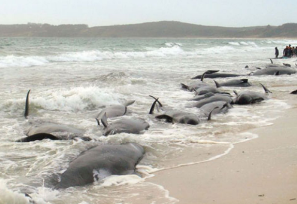Radiation Effects on Dolphins & Whales
After the disaster in Fukushima hundreds of whale carcasses washed up on the shores. It was a frightening scene for locals that were told not to worry about harm from radiation coming off of the plant and there were few answers to what it meant for the ecosystem. It is difficult for scientists to ascertain the true extent of the contamination; however, it has affected species from the bottom up, and the Japanese government has remained silent about today’s latest events.
The radiation from the Fukishima leaking plant was deposited in the sediment. On the coast of Japan sediment gets picked up and deposited in areas along the coast, due to the Kuroshio Current. The Kuroshio moves water down stream and across the length of Japan, into the East China Sea. Because of where Fukushima is located, the radiation was not immediately dispersed into the current.
The Pacific Ocean contains over 21 dolphin and whale species. The quality of life for sea life along the coast of Japan and the Pacific Ocean has diminished as a result of the radiation. Many species have had their habitats disrupted and become ill from the pollution. These species cover large swathes of territory and often have to feed on fish that have been contaminated.
Several species of fish that dolphins and whales survive on have been heavily contaminated by radiation. The animals are eating large quantities of fish, feeding on high doses of radiation and becoming ill as radiation compounds in their bodies. The effects from consuming radiation are not immediate, but slowly take effect over time; sometimes the damage are not apparent until years after contamination.
One of the species most at risk is the gray whale, which has to scoop up sediment from the bottom of the ocean while hunting krill. Radiation is more heavily concentrated at the bottom, where they are hunting, so they are consuming it in higher doses. The radiation is devastating populations of gray whales.
Despite radiation decay, the impact of radiation is still present. Radiation continues to pour into the gulf. Dolphins, whales and other species are suffering from the increased radiation present, struggling to adapt in a short time period. It is unclear how far reaching the effects will be, but the radiation is already having impacts over the Pacific Ocean.
Governments will have to rethink policies toward hunting policies in regards to whales and dolphins. Otherwise, many other species may become endangered. More research will have to be conducted to determine how radiation poisoning has hurt populations of whales and dolphins and what this might mean for their survival.
http://blog.seattlepi.com/candacewhiting/2011/03/22/how-japans-nuclear-crisis-might-affect-whales-and-dolphins/
http://www.washingtonsblog.com/2013/12/fukushima-radiation-something-else-causing-mass-die-wildlife-pacific-ocean.html
http://nationalreport.net/breaking-fukushima-disaster-leaves-hundreds-whales-beached/

